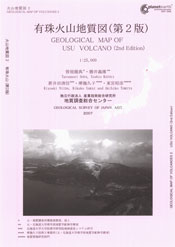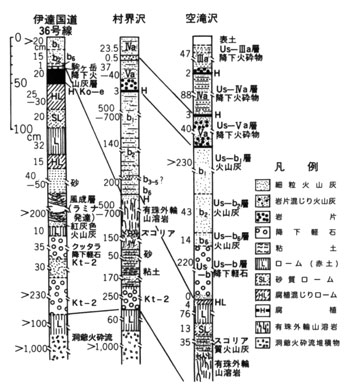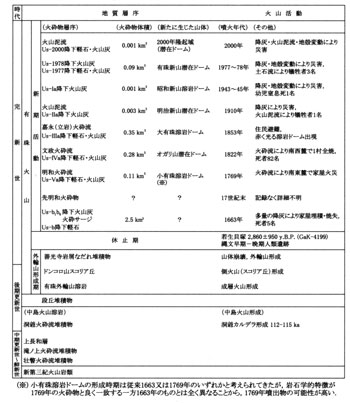Usu Volcano - 2nd Edition -
Introduction to the 1st edition (1981) / 1: Geology of Usu Volcano and environments / 2: Outline of Usu Volcano
3: Eruptions of historical times Characteristics of the eruptions of historical times
4: Rocks of Usu Volcano
5: Surveillance and observation of activities / 6: Prediction of future activities and mitigation of damage
References / Note
![]() PREV
PREV ![]() NEXT
NEXT
Introduction to the 1st edition / 1:Geology of Usu Volcano and environments / 2:Outline of Usu Volvano
Introduction to the 1st edition
Seven eruptions since 1663 ( the 3rd year of Kanbun ) have been documented ( note: as of 1981 ) for Usu Volcano, a part of Shikotsu-Toya National Park, which make Usu one of the most active volcanoes in Japan. Recent volcanic products, Meiji-shinzan ( 1910 ), Showa-shinzan (1943 - 45 ), and Usu-shinzan ( 1977 - 78 ), show peculiar volcanic shape resulting from highly viscous silicic magma. Around Usu are textbook volcanic topographies, rich volcanic soil, and many hot springs contributing to sightseeing, agriculture, forestry, and fishery. Over five million sightseers annually visit this region. However, development of volcanic regions needs special caution against various potential hazards such as eruption, collapse of mountain, and mud flow (lahar). This is a lesson learned anew from the eruption of 1977 - 78. This map was prepared as a compilation of many av1111ailable geologic studies. We hope the map is widely utilized not only for future geologic studies but for mitigation of eruption hazard, economic development, and sightseeing.
1: Geology of Usu Volcano and environments
In the northern shore area of Uchiura Wan ( Bay ), SW Hokkaido, is Lake Toya; well known for its clear water. It is a round caldera lake with diameter of about 10 km the surface of which is at 84 m a.s.l. and the average depth of 110 m ( maximum depth 179 m ). In its center is an island, Nakajima Volcano, consisting of cluster of pyroxene hornblende andesite lava domes. On the southern side of the lake is Usu Volcano. According to Bouguer anomaly, Toya Caldera belongs to low gravity anomaly type being its center lower by 11 mgal than that in the peripheral region.
Surrounding area of Lake Toya is widely underlain by altered Neogene andesite and pyroxene andesite both making up basement of the area. Sobetsu Pyroclastic Flow Deposits ( rhyolitic and largely non-welded ) and Takinoue Pyroclastic Flow Deposits (andesitic and largely non-welded) believed to have erupted in Early Pleistocene are distributed from near Takinoue, Sobetsu, to the eastern shore of Lake Toya. On the eastern bank of Osaru river is exposed Kaminagawa Beds ( Middle Pleistocene ) consisting of gravel, sand, and mud overlying Takinoue Pyroclastic Flow Deposits. Kaminagawa Beds are also distributed in the hills near Izumi area of Toyako Town. Those Pleistocene beds are widely distributed as the basement of Usu Volcano, and exposed at the surface in Showa-shinzan after its uplift.
In the Late Pleistocene there was a large scale eruption of pumice near the present-day center of Lake Toya and the caldera was formed. The ejecta at this time was Toya Pyroclastic Flow Deposit, which reached Iwanai coast of Japan Sea to the north, passing the foot of Mt. Yotei and crossing Ninaruka Plateau. It also deposited at the foot of Mt. Usu and City of Date to the south. The total volume of Toya Pyroclastic Flow Deposit is estimated to be more than 20 km3, and wide-spread volcanic ash deposit is estimated to be more than 150 km3 ( Machida and Arai, 2003 ). On the plateau formed by the pyroclastic flow deposit on the left bank of downstream of Osaru river, two flow units, upper and lower, are recognized. The lower unit is pale reddish ash flow while upper one is reddish grey-white pumice flow, both of which are non-welded. The lithology of both is pyroxene rhyolite. The eruption age is estimated to be 112,000 to 115,000 years BP ( Machida and Arai, 2003 ) from radiometric ages, oxygen isotope stratigraphy, and wide area tephrostratigraphy ( ![]() Table 1 and
Table 1 and ![]() Fig. 1 ).
Fig. 1 ).
2: Outline of Usu Volvano
Usu is a volcano with double ring structure formed on the south wall of Toya Caldera. It is composed of a basaltic to basaltic-andesitic stratovolcano ( diameter of its base 6 km and difference in elevation about 500 m ) with about 1.8 km diameter somma, a lateral volcano ( Donkoroyama Scoria Cone ), three dacite lava domes ( Kousu, Ousu, and Showa-shinzan ), and many cryptodomes ( e.g., Nishiyama, Kompira Yama, Nishi-maruyama, Meiji-shinzan, Higashi-maruyama, Ogariyama, Usu-shinzan, and the area of upheaval during the 2000 activity). Cryptodomes were formed by uplift of ground surface with viscous magma intrusions. Actual example of cryptodome formation was described in 1910 for the first time in the formation of Meiji-shinzan. Lava domes of Usu were invariably related to very viscous nature of dacitic magma which first formed cryptodomes followed by lava breaking the ground surface. The surface of cryptodome is characteristically covered by red brick-like color layer with scratch marks. The domes are aligned in two zones with NW-SE direction, one of which runs through the summit and another on the northern foot. Some of the domes were formed in historical times according to old documents.
The beginning of Usu goes back to 10,000-20,000 years BP ( ![]() Table 1 ). It started with basaltic to basaltic-andesitic lava/scoria eruptions on the south wall of Toya caldera ( Usu Somma Lava ). The early ejecta flowed down to inside of the caldera at first. With the growth of the mountains the ejecta started to flow to outside of caldera and eventually formed a conical stratovolcano. At this stage a small scoria cone ( Donkoroyama ) was formed along the caldera wall in the NE foot area. About 7,000 to 8,000 years ago the summit of Usu was collapsed, so that the mountain became like today's Bandaisan. The debris from this explosion flowed down the southern slope to form hummocky topography there ( Zenkoji Debris Avalanche Deposits ). The debris avalanche engulfed Toya Pyroclastic Flow Deposits and Kaminagawa Bed besides Usu Somma Lava, and formed complex shoreline of Usu Wan ( Bay ). The deposit of this time has been quarried here and there. Early to late Jomon archaeological sites ( Wakkaoi shell mounds ) are found distributed above the debris avalanche deposit. Volcanic ejecta belonging to the period of several thousand years after this have not been identified in Usu. Therefore, the volcano was dormant for a long period. During this time, extremely silicic magma had evolved within the volcano, and historical activities have resumed from 1663 ( the 3rd year of Kanbun ), starting in the form of Plinian pumice eruption. In historical times, Usu erupted repeatedly in pumiceous, ash, and phreatic eruptions. Accompanied with those were pyroclastic surges and pyroclastic flows in addition to formation of many lava domes and cryptodomes.
Table 1 ). It started with basaltic to basaltic-andesitic lava/scoria eruptions on the south wall of Toya caldera ( Usu Somma Lava ). The early ejecta flowed down to inside of the caldera at first. With the growth of the mountains the ejecta started to flow to outside of caldera and eventually formed a conical stratovolcano. At this stage a small scoria cone ( Donkoroyama ) was formed along the caldera wall in the NE foot area. About 7,000 to 8,000 years ago the summit of Usu was collapsed, so that the mountain became like today's Bandaisan. The debris from this explosion flowed down the southern slope to form hummocky topography there ( Zenkoji Debris Avalanche Deposits ). The debris avalanche engulfed Toya Pyroclastic Flow Deposits and Kaminagawa Bed besides Usu Somma Lava, and formed complex shoreline of Usu Wan ( Bay ). The deposit of this time has been quarried here and there. Early to late Jomon archaeological sites ( Wakkaoi shell mounds ) are found distributed above the debris avalanche deposit. Volcanic ejecta belonging to the period of several thousand years after this have not been identified in Usu. Therefore, the volcano was dormant for a long period. During this time, extremely silicic magma had evolved within the volcano, and historical activities have resumed from 1663 ( the 3rd year of Kanbun ), starting in the form of Plinian pumice eruption. In historical times, Usu erupted repeatedly in pumiceous, ash, and phreatic eruptions. Accompanied with those were pyroclastic surges and pyroclastic flows in addition to formation of many lava domes and cryptodomes.
![]() PREV
PREV ![]() NEXT
NEXT

 ZOOM
ZOOM  ZOOM
ZOOM